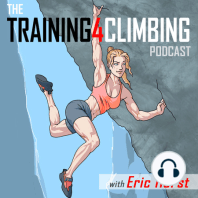60 min listen

Episode #26: Energy System Training (part 4) - Aerobic Power!
Episode #26: Energy System Training (part 4) - Aerobic Power!
ratings:
Length:
90 minutes
Released:
Jun 21, 2018
Format:
Podcast episode
Description
This is the fourth in a series on using bioenergetic energy systems as a guiding model to train more effectively. This epic 90-minute episode breaks down the nuance of properly training both the climbing-specific and generalized aerobic energy system—a critical and often-overlooked metabolic pathway that contributes significantly to power production in climbing and, importantly, drives most of the recovery process between moves, crux sequences, climbing, and even boulder problems. There's lots of gold to mine from this podcast, especially for already highly training intermediate to elite climbers. Podcast Rundown 00:15 – Eric’s Intro to training the aerobic energy system…and its high importance to rock climbers. How the energy system conceptual model can empower you to train smarter and get more out of your training investment. 4:45 – If you think these podcasts are gold, then why not share it with your friends….and please leave a review on iTunes! 5:15 – All about the aerobic energy system and how it differs from the other two energy systems. Of course, all three energy systems contribute to ATP production, but there are certain climbing situations that call heavily on the aerobic energy system. 9:15 – A quick review of the three energy systems, when each dominates, and how the aerobic system comes into play for climbers. Learn why and when the anaerobic energy systems power down and eventually fail you…and how the aerobic energy system can only provide a sustained “critical power” of only about one-third of your peak power. 15:35 – How the aerobic energy system supports the ATP-CP energy system. Important stuff, especially for rope climbers…but really for all climbers. 18:20 – How the aerobic system supports the anaerobic lactic energy system. Yes, a stronger aerobic system can help you control the “pump”; but it’s also important that you strive to improve climbing economy and reduce the ATP cost of a given move or sequence—this is a hugely powerful distinction! 21:55 – A quick reminder on the importance of increasing maximum strength and power, season over season, because this sets the ceiling for your peak power output and anaerobic capacity. 23:50 – A detail discussion of the bioenergetics of finger flexor muscles and how finger grip intensity determines the energy system most used. Occlusion of blood flow is the critical factor, and maintaining blood flow as much as possible is one of the secrets of elite climbers. 28:45 – The physical prowess of Adam Ondra is both his large anaerobic reserve (capacity) AND high aerobic power! 30:35 – What climbing researchers have measured in the lab with regarding to the bioenergetics of climbing. (A truly climbing-specific VO2 test has yet to be developed and validated for testing at the gym.) The importance of not conflating generalized aerobic fitness (and VO2) with climbing-specific aerobic development (and VO2). 32:34 – Moving from theory to practice…here we begin to look into targeted training of the finger flexors and pulling muscles (the rock climbing agonists). 34:09 - What adaptations take places in the climbing muscles that improve aerobic power? Adaptation #1 in an increase in capillary density which results in a decrease in diffusion distance—importantly, this contributes to increasing O2 kinetics. Simon Fryer’s research showed that elite climbers have higher O2 kinetics than lesser climbers. 37:50 – Adaptation #2 is an increase in aerobic enzymes…which can upregulate in just a matter of days to a week or two of aerobic-centric training/climbing. 40:15 – Adaptation #3 is mitochondria adaptations—critical for long-term development year over year…and for maintaining climbing-specific VO2 into middle age and beyond. 43:30 – Important point: Intracellular acidosis negatively impacts mitochondria function. This explains why a vicious flash pump (due to a poor warm up) can hurt same-day climbing performance…and why chronic acidosis (too much time spent anaerobic lactic trainin
Released:
Jun 21, 2018
Format:
Podcast episode
Titles in the series (98)
Episode #24: Energy System Training (part 3) - Anaerobic Capacity Training: Anaerobic Lactic System Part 2 (Conclusion of episode #23) by Eric Hörst's Training For Climbing Podcast